INSTITUT SUPERIEUR D'ANTHROPOLOGIE
INSTITUTE OF ANTHROPOLOGY
ONLINE COURSES / COURS A DISTANCE
SUMMER TERM : JULY 2014
REGISTER NOW
BULGARIE – 
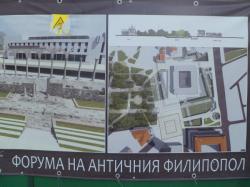 Plovdiv - This emerged as the 2014 archaeological season in Plovdiv was formally opened. Work this year will include part of the Roman Forum and the area being excavated will be extended to the north-east. In 2013, three columns were found at the Roman Forum site, and there is an idea for these to be restored and incorporated into a future design of the central square in the city. Archaeologists have already reached the oldest period of the Forum site, which dates back between the first century BCE to the end of the first century CE. Important finds so far include coins minted during the reigns of Augustus, Claudius and Vespasian. Another was a sword of the Gladius type, adopted by Rome from Iberian tribes. Significant evidence had been found of medieval Plovdiv, from the end of the 12th century, when the Forum was destroyed, as well as Turkish kilns from the 17th and 18th century.
Plovdiv - This emerged as the 2014 archaeological season in Plovdiv was formally opened. Work this year will include part of the Roman Forum and the area being excavated will be extended to the north-east. In 2013, three columns were found at the Roman Forum site, and there is an idea for these to be restored and incorporated into a future design of the central square in the city. Archaeologists have already reached the oldest period of the Forum site, which dates back between the first century BCE to the end of the first century CE. Important finds so far include coins minted during the reigns of Augustus, Claudius and Vespasian. Another was a sword of the Gladius type, adopted by Rome from Iberian tribes. Significant evidence had been found of medieval Plovdiv, from the end of the 12th century, when the Forum was destroyed, as well as Turkish kilns from the 17th and 18th century.
http://sofiaglobe.com/2014/05/28/archaeology-2014-excavation-season-opens-in-bulgarias-plovdiv
ROYAUME UNI – 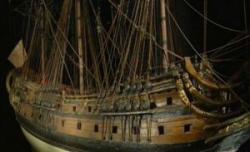 Thames Estuary - Archaeological excavation of the protected 17th century shipwreck London has begun in the Thames Estuary. The work is an emergency measure, with English Heritage saying that the historically important warship is “rapidly deteriorating” due to a shifting seabed which exposes artefacts and allows them to be washed away. Divers, working under the control of English Heritage, Cotswold Archaeology and the wreck’s licensee Steven Ellis, started work last week but three out of six planned diving days were blown out due to bad weather.
Thames Estuary - Archaeological excavation of the protected 17th century shipwreck London has begun in the Thames Estuary. The work is an emergency measure, with English Heritage saying that the historically important warship is “rapidly deteriorating” due to a shifting seabed which exposes artefacts and allows them to be washed away. Divers, working under the control of English Heritage, Cotswold Archaeology and the wreck’s licensee Steven Ellis, started work last week but three out of six planned diving days were blown out due to bad weather.
The London, a Second Rater sunk in 1665 by an unexplained onboard explosion, lies in two main pieces in 18m of water. The archaeological divers will be accessing various parts of the wreck to recover items of historical and cultural importance “before they are lost forever”.
http://www.divernet.com/home_diving_news/2414953/warship_excavation_begins.html
INDE – 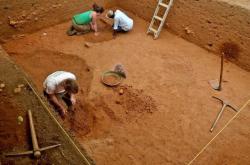 Pattanam - Prof. Chris Gosden, Chair of European Archaeology at Oxford University who was at the Pattanam archeological site last month, said Pattanam witnessed flourishing trade with numerous countries. “The people there exported gems, spices, wine and food to the Roman world. The Romans were profoundly influenced by their Indian connections. When we read the history of Europe, it would seem that the people got inspiration only from Athens and Rome. But it is now clear that Persian and Indian cultures were important influences. It is obvious from the architectural and artefact evidence that Pattanam is a site of great importance,” he said in a lecture on ‘Ancient Global Connections and Pattanam’ here. He said Kerala was the epitome of multicultural mix of societies that have lived together in healthy co-existence for centuries. However, the surprising aspect of the evidence from Pattanam and other sites in India is the scale of connections with different parts of the world.
Pattanam - Prof. Chris Gosden, Chair of European Archaeology at Oxford University who was at the Pattanam archeological site last month, said Pattanam witnessed flourishing trade with numerous countries. “The people there exported gems, spices, wine and food to the Roman world. The Romans were profoundly influenced by their Indian connections. When we read the history of Europe, it would seem that the people got inspiration only from Athens and Rome. But it is now clear that Persian and Indian cultures were important influences. It is obvious from the architectural and artefact evidence that Pattanam is a site of great importance,” he said in a lecture on ‘Ancient Global Connections and Pattanam’ here. He said Kerala was the epitome of multicultural mix of societies that have lived together in healthy co-existence for centuries. However, the surprising aspect of the evidence from Pattanam and other sites in India is the scale of connections with different parts of the world.
http://www.thehindu.com/news/cities/Kochi/pattanam-saw-flourishing-trade-with-countries/article6056563.ece?utm_source=RSS_Feed&utm_medium=RSS&utm_campaign=RSS_Syndication
ROYAUME UNI – 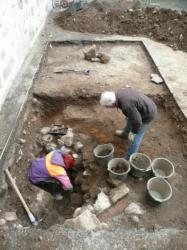 Drum - Archaeological excavations currently under way at Drum Castle have revealed ground flushed with medieval sanitary arrangements. The dig is gradually revealing substantial remains of long-lost structures that once surrounded the 14th-century Tower of Drum. The excavations are part of the ongoing National Trust conservation project which saw the tower reopened to the public last month after a year behind scaffolding. A trench in the castle courtyard is concentrating on exploring Drum’s historical sanitary arrangements. So far a large, stone-lined cesspit has been found, which would have taken the waste from two garderobes, or toilets, within the tower, as well as receiving waste from an outdoor toilet. Animal bones and shards of medieval pottery have been found in the upper levels of the pit. Archaeologists are hoping that waterlogged items such as grains, seeds and fish bones may be preserved in the lower levels of the cesspit, which would give an insight into what people in the castle had been eating. The dig is also uncovering remains of a building which lay next to the brewhouse until the early 19th century.
Drum - Archaeological excavations currently under way at Drum Castle have revealed ground flushed with medieval sanitary arrangements. The dig is gradually revealing substantial remains of long-lost structures that once surrounded the 14th-century Tower of Drum. The excavations are part of the ongoing National Trust conservation project which saw the tower reopened to the public last month after a year behind scaffolding. A trench in the castle courtyard is concentrating on exploring Drum’s historical sanitary arrangements. So far a large, stone-lined cesspit has been found, which would have taken the waste from two garderobes, or toilets, within the tower, as well as receiving waste from an outdoor toilet. Animal bones and shards of medieval pottery have been found in the upper levels of the pit. Archaeologists are hoping that waterlogged items such as grains, seeds and fish bones may be preserved in the lower levels of the cesspit, which would give an insight into what people in the castle had been eating. The dig is also uncovering remains of a building which lay next to the brewhouse until the early 19th century.
http://www.deesidepiper.co.uk/news/local-headlines/drum-excavations-unearth-medieval-sanitation-system-1-3424812
ROYAUME UNI –  Finavon - Located a mile up from the B1934 road, is the Finavon Hill Iron Age fort, which dates back to the seventh century BC. The fort was an elongated heavily vitrified timer-laced fort, which also housed a well inside. The site was first excavated in 1933/4 by archaeologist, Vere Gordon Childe, which revealed that the fort’s walls were around 20 inches thick. Childe’s dig also uncovered a row of dwellings with hearths at the north wall. Artefacts found in the dig included flings, an iron ring, stone whorls and a thick jet ring. Further investigations into the historic site in 1966 by Euan Wallace Mackie led to the dating of the fort. The research revealed that the fort was used until the late fifth, or early fourth century before it was destroyed.
Finavon - Located a mile up from the B1934 road, is the Finavon Hill Iron Age fort, which dates back to the seventh century BC. The fort was an elongated heavily vitrified timer-laced fort, which also housed a well inside. The site was first excavated in 1933/4 by archaeologist, Vere Gordon Childe, which revealed that the fort’s walls were around 20 inches thick. Childe’s dig also uncovered a row of dwellings with hearths at the north wall. Artefacts found in the dig included flings, an iron ring, stone whorls and a thick jet ring. Further investigations into the historic site in 1966 by Euan Wallace Mackie led to the dating of the fort. The research revealed that the fort was used until the late fifth, or early fourth century before it was destroyed.
http://www.brechinadvertiser.co.uk/what-s-on/leisure/finavon-hill-fort-1-3424020
Cambodge – 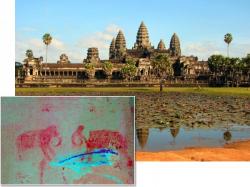 Angkor Vat - Angkor Wat may be covered in graffiti—but don’t worry, it’s invisible. Built in the early 12th century, Cambodia’s architecturally iconic temple is known for its intricate carvings, some of them stretching nearly a kilometer in length. But most archaeologists believe that parts of the temple were once painted as well. So when scientists noticed faint traces of red and black pigment on the walls of several rooms in Angkor Wat, they snapped pictures with a bright flash and used a tool called decorrelation stretch analysis to digitally enhance the images. Previously used to highlight subtle color differences in images of the martian landscape taken by NASA’s Opportunity rover, this type of analysis can reveal colors too faint or faded to be seen with the naked eye. When the researchers applied it to their photos of Angkor Wat, they found more than 200 images of boats, deities, buildings, and animals—like the elephants above (inset)—drawn on the walls throughout the temple, they report today in Antiquity. Most of the paintings are haphazardly arranged and appear to be graffiti left by visitors after Angkor Wat was first abandoned in 1431. But one group of carefully drawn scenes, located in the highest tier of one of Angkor Wat’s towers, might be the remains of a 16th century restoration program, when the complex was transformed from a Hindu temple into a Buddhist shrine. The previously lost images could give archaeologists new insight into this little-known period in Cambodia’s history.
Angkor Vat - Angkor Wat may be covered in graffiti—but don’t worry, it’s invisible. Built in the early 12th century, Cambodia’s architecturally iconic temple is known for its intricate carvings, some of them stretching nearly a kilometer in length. But most archaeologists believe that parts of the temple were once painted as well. So when scientists noticed faint traces of red and black pigment on the walls of several rooms in Angkor Wat, they snapped pictures with a bright flash and used a tool called decorrelation stretch analysis to digitally enhance the images. Previously used to highlight subtle color differences in images of the martian landscape taken by NASA’s Opportunity rover, this type of analysis can reveal colors too faint or faded to be seen with the naked eye. When the researchers applied it to their photos of Angkor Wat, they found more than 200 images of boats, deities, buildings, and animals—like the elephants above (inset)—drawn on the walls throughout the temple, they report today in Antiquity. Most of the paintings are haphazardly arranged and appear to be graffiti left by visitors after Angkor Wat was first abandoned in 1431. But one group of carefully drawn scenes, located in the highest tier of one of Angkor Wat’s towers, might be the remains of a 16th century restoration program, when the complex was transformed from a Hindu temple into a Buddhist shrine. The previously lost images could give archaeologists new insight into this little-known period in Cambodia’s history.
http://news.sciencemag.org/archaeology/2014/05/invisible-graffiti-angkor-wat?